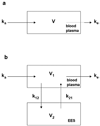Dynamic Contrast Enhanced Magnetic Resonance Imaging in Oncology: Theory, Data Acquisition, Analysis, and Examples
- PMID: 19829742
- PMCID: PMC2760951
- DOI: 10.2174/157340507780619179
Dynamic Contrast Enhanced Magnetic Resonance Imaging in Oncology: Theory, Data Acquisition, Analysis, and Examples
Abstract
Dynamic contrast enhanced MRI (DCE-MRI) enables the quantitative assessment of tumor status and has found application in both pre-clinical tumor models as well as clinical oncology. DCE-MRI requires the serial acquisition of images before and after the injection of a paramagnetic contrast agent so that the variation of MR signal intensity with time can be recorded for each image voxel. As the agent enters into a tissue, it changes the MR signal intensity from the tissue to a degree that depends on the local concentration. After the agent is transported out of the tissue, the MR signal intensity returns to its' baseline value. By analyzing the associated signal intensity time course using an appropriate mathematical model, physiological parameters related to blood flow, vessel permeability, and tissue volume fractions can be extracted for each voxel or region of interest.In this review we first discuss the basic physics of this methodology, and then present technical aspects of how DCE-MRI data are acquired and analyzed. We also discuss appropriate models of contrast agent kinetics and how these can be used to elucidate tissue characteristics of importance in cancer biology. We conclude by briefly summarizing some future goals and demands of DCE-MRI.
Figures






References
-
- Ribatti D, Vacca A, Presta M. The discovery of angiogenic factors: a historical review. Gen Pharmacol. 2000;35:227–231. - PubMed
-
- Folkman J. Role of angiogenesis in tumor growth and metastasis. Semin Oncol. 2002;29 6 Suppl 16:15–18. - PubMed
-
- Folkman J. Angiogenesis in cancer, vascular, rheumatoid and other disease. Nat Med. 1995;1:27–31. - PubMed
-
- Atri M. New Technologies and Directed Agents for Applications of Cancer Imaging. J Clin Onc. 2006;24:3299–3308. - PubMed
-
- Carmellet P, Jain RK. Angiogenesis in cancer and other diseases. Nature. 2000;407:249–257. - PubMed
Grants and funding
LinkOut - more resources
Full Text Sources
Other Literature Sources
Medical
Research Materials
